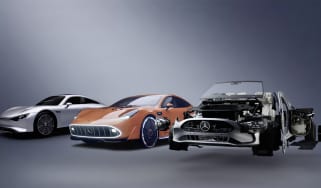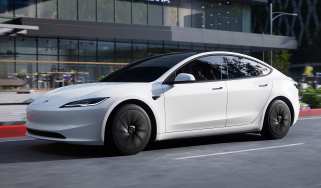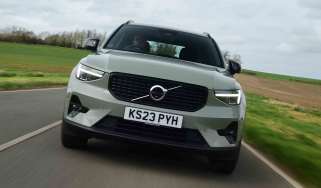UK low emission zones explained: Do LEZs and CAZs affect my car?
Low emissions zones are springing up around the country, here’s what you need to know…

It won’t have escaped your notice that the car industry is undergoing a huge upheaval right now, moving away from more than a century of combustion vehicles and towards a future dominated by electric power, in an attempt to reduce the environmental impact of transportation.
That same environmental imperative is also why some individual towns and cities are taking matters into their own hands, placing restrictions on certain types of vehicle in order to protect the health of everyone using the city from airborne pollution.
These are taking the form of low emission zones and clean air zones, or LEZs and CAZs, with a number of local authorities levying charges on different vehicles if they need to enter one of these zones.
If you don’t already live in one of the affected towns or cities though, the idea of an LEZ or CAZ can be confusing – so we’ve put together this guide explaining what these zones are for, where you can expect to find them, and how much you might need to pay if you don’t have a car that meets the rules.
What is a low-emission zone?
A low emission zone (LEZ) or clean air zone (CAZ) is a designated area, typically in a town or city, where vehicles are required to either meet a particular emissions standard in order to enter or pass through, or to pay a fee to access. Sometimes, it’s a combination of both.
The best known LEZ is the London ULEZ or Ultra Low Emission Zone, which started off as a small area within the city like the Congestion Charge zone, but in 2023 expanded to cover almost all of the area inside the M25 London orbital motorway. The London ULEZ was imposed to try and reduce the number of older and more polluting cars using the city’s roads and is based on a vehicle’s Euro emissions standard – though as we’ll explain below, more recent vehicles aren’t the only ones exempt.
Several other cities around the UK (and indeed, even more around Europe) have LEZs and CAZs, though the standard required for each can be slightly different, which can make things confusing if you’ve not been to a particular city before. Other cities are considering LEZs and CAZs but may not yet have implemented them.
Are any cars exempt from LEZs?
This depends very much on the particular LEZ or CAZ. Given its large population, London’s ULEZ is probably the most impactful and most influential. It is likely to be used as a model for other cities going forward, so we’ll concentrate on this and refer to any other relevant exemptions in our list of specific LEZ rules in towns and cities below.
For a car to be exempt from the London ULEZ, it must be either a petrol model meeting Euro 4 or better emissions standards for NOx emissions (oxides of nitrogen), or a Euro 6 or better diesel, which is limited by NOx and PM (particulate matter) such as soot.

Broadly speaking, that means eligible petrol cars tend to have been produced after 2001 when some Euro 4 cars first went on sale, and much later for diesels, with the first eligible cars arriving in 2015. A checker on the Transport for London (TfL) website lets you type in your car’s registration number to verify whether or not it’s exempt.
The same rules apply for vans and minibuses, while the standard drops to Euro 3 for motorcycles, scooters, mopeds, and quadricycles.
There are other ULEZ exemptions though. The obvious one is electric cars, which should remain exempt thanks to their zero-emissions status. But also, if a car was first registered more than 40 years ago, then it too will be exempt from the ULEZ, just as cars of this age or older don’t require an MOT and aren’t subject to VED or ‘road tax’. However, you’d be wise to check with TfL if you have an older vehicle that it’s registered as exempt, as it’s not unusual for a car to be incorrectly charged despite being more than 40 years old.
Where are the current UK low emission zones located?
Several UK towns and cities currently have LEZs or CAZs in place. Most have slightly different standards and requirements, and some zones are more widespread than others, so below we’ve summarised the most significant zones, what you’ll need to drive around in them, and how much you’ll pay to enter.
London
This is the biggie, considering it potentially affects around 2.5 million vehicles. The London Ultra Low Emission Zone or ULEZ currently extends as far as the M25 in some places and as far as private motorists are concerned, affects essentially everyone. Cars and vans are expected to meet either Euro 4 emission standards for petrol models or Euro 6 for diesels (or EVs, which are exempt), while motorcycles need to be Euro 3 or better.
Those that don’t meet the standards (assuming they aren’t classics of more than 40 years old), are required to pay £12.50 for any day they drive within the zone – and this is additional to the £15 daily Congestion Charge, if your destination is also in that smaller zone. Fail to pay, and you’ll be subject to a £180 fine, halved if you pay within 14 days.
Oxford
Oxford has had a central zero emissions zone pilot since 2022, and a daily charge of between £2-£10 per day (depending on emissions class) for all vehicles other than pure electric models. The zone currently only covers a handful of streets in the city centre, but as one of the stricter local authorities in the country on vehicle pollution, we’d expect this zone to expand in the coming years.
Birmingham
Since 2021, Birmingham has levied a charge of £8 per day on vehicles entering its CAZ, with the same restrictions as those used in London – Euro 4 for petrol vehicles, and Euro 6 for diesels. Electric vehicles are exempt.
Bristol
Bristol’s CAZ has been in place since late 2022 and covers a sizable area of the city centre. Once again, the standards it uses match those in London, and this also means exemption for electric vehicles. Non-compliant private cars must pay £9 per day.
Other LEZs and CAZs
The towns and cities above currently all require either compliance or a charge for vehicles to enter, but there are several more LEZ and CAZs across the UK that are in place, but less strict and may not apply to private motorists – at least for the time being. In alphabetical order, these include:
Aberdeen – A small area in the centre of Aberdeen has been designated a LEZ. Full details are not yet in place but it will come into force from June 2024. Blue Badge holders will be exempt, providing they register their car with the scheme.
Bath – The city has a CAZ in place which requires LGVs, vans, private hire vehicles and taxis to pay £9 per day, and £100 for HGVs, buses and coaches – but nothing yet for private vehicles.
Bradford – Bradford is another city with a CAZ focused more on commercial and business vehicles than private ones, with charges since 2022. Private vehicles are not yet affected.
Brighton – This coastal town has had an LEZ in place since as far back as 2015, but only for buses, and more recently this expanded to include taxis, which now have to meet Euro 6 regulations. With a strong Green party political influence, the city is considering an outright ban on cars in its centre at some point.
Dundee – There aren’t many details in place yet, but Dundee introduced an LEZ in 2022 that will come into place in May 2024.
Edinburgh – Much like Dundee, the city of Edinburgh created an LEZ in 2022 but doesn’t intend to implement it until May 2024.
Glasgow – Slightly different from its Scottish neighbours, Glasgow has actually had a small city-centre LEZ that applies to buses since 2019, and that expanded to include cars in 2023. Electric cars, motorcycles and scooters, and Blue Badge holders are exempt, among a handful of others.
Greater Manchester – A total of ten towns and cities in Greater Manchester all have CAZs in place, so we’re mixing them all under the region rather than individually. Manchester, Trafford, Salford, Wigan, Bolton, Bury, Rochdale, Oldham, Tameside, and Stockport have all had a scheme in place since May 2022, focused on buses, coaches, HGVs and private hire vehicles, though there’s nothing currently in place for private cars.
Newcastle-upon-Tyne/Gateshead – There’s nothing in place for private vehicles yet, but these two cities on either side of the Tyne do currently charge buses, coaches, and vans, and are evaluating further restrictions.
Portsmouth – One imagines ships and ferries cause more pollution than cars in Portsmouth, but the city is also implementing a charge for taxis, coaches, HGVs and vans. Private cars and more recent, emission-compliant vehicles are unaffected.
York – This historic northern city has had a CAZ for buses since 2020, and while there’s no current charge for private vehicles, the city is considering an outright ban in some areas.
Want to completely cut out your exhaust emissions? These are the best electric cars you can buy...
Find a car with the experts









